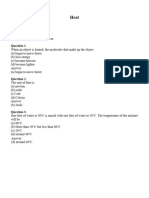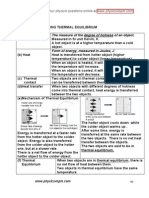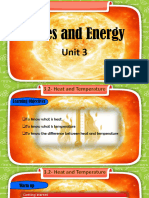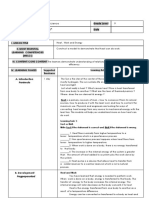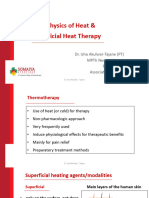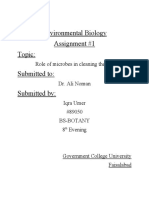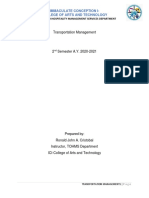Earth Science Student Book - CPO Focus On-87-93
Earth Science Student Book - CPO Focus On-87-93
Uploaded by
jhonatanCopyright:
Available Formats
Earth Science Student Book - CPO Focus On-87-93
Earth Science Student Book - CPO Focus On-87-93
Uploaded by
jhonatanOriginal Title
Copyright
Available Formats
Share this document
Did you find this document useful?
Is this content inappropriate?
Copyright:
Available Formats
Earth Science Student Book - CPO Focus On-87-93
Earth Science Student Book - CPO Focus On-87-93
Uploaded by
jhonatanCopyright:
Available Formats
Chapter 4
Heat
Have you ever seen a hot air balloon float high above Earth’s
surface? What about a hang glider or a soaring bird of prey
like a hawk? Each of these objects—a hot air balloon, a hang
glider, and a hawk—take advantage of heat to “fly.” In this
chapter, you will learn about heat and temperature and how
they affect natural events and human activities.
1. What is the difference between heat and
temperature?
2. Why does an ice cube melt in your hand?
3. Does the Sun help a hawk to fly?
4.1 What Is Heat?
What happens to an ice cube when you hold it in your hand? The ice melts because molecule - a group of atoms.
heat flows from your hand to the ice cube. We’ve all experienced the effects of heat,
kinetic energy - energy of
but what exactly is heat? motion.
Atoms and molecules
Particles of Matter is made of tiny particles called atoms that are too small to
matter move see with your eyes or even with a magnifying glass (Figure 4.1). In
constantly most matter, atoms occur in a group called a molecule. Atoms and
molecules move constantly. The molecules of the water you drink
and the air you breathe are moving. Molecules in an ice cube are
moving. All of the atoms of your body are moving constantly, too—
even when you are asleep!
Kinetic energy Imagine what it would be like to live in an atom-sized world. If you
were suddenly shrunk to the size of an atom, you would be pushed
and shoved by all the atoms and molecules around you. Watch out!
Atoms and molecules whiz by at amazingly fast speeds! The
constant motion of atoms is a form of energy. The energy of motion
is called kinetic energy. Faster atoms have more kinetic energy
than slower atoms.
Figure 4.1: The thickness of a sheet
of aluminum foil is about 200,000 atoms
across. Important note: Atoms are too
small to see with your eyes or a
magnifying glass!
76 UNIT 2 ENERGY IN EARTH’S SYSTEMS
CHAPTER 4: HEAT
Heat and temperature
What is heat? Heat is a form of energy caused by the motion of atoms and
molecules.* Heat is the sum of the kinetic energy of each atom heat - a form of energy caused by
in a sample. This means that a bucket of hot water has more heat the motion of atoms and
molecules.
energy than a cup of hot water. The bucket contains more hot
water molecules than the cup. More molecules means more temperature - a measure of the
motion and more heat energy. average speed of a sample
containing lots of atoms.
What is Temperature is related to heat, but it isn’t the same thing.
temperature? Temperature is a measure of the average speed of atoms in a
sample. The average speed of the atoms in a hot object is fast.
The average speed in a cold object is slow (Figure 4.2).
What is your Sometimes when you are sick, your forehead feels very warm and a
temperature? thermometer might show a temperature of 100°F or more. The
normal temperature for the human body is 98.6°F. A thermometer
measures the average kinetic energy of the atoms in your body.
Figure 4.2: The average speed of
atoms in a hot object is fast. The average
speed of atoms in a cold object is slow.
* Footnote: This definition of heat was adapted to be appropriate for the level and content of this text.
4.1 WHAT IS HEAT?
77
Summary of heat and temperature
An example If you wanted to warm up a swimming pool of water you need heat
energy. Here are two methods for warming the water. Which When two equal volumes of water
method is the best? are mixed, the final temperature of
the mixture is halfway between the
• Warm the water with a teacup of water at 100°C, or two original temperatures.
• Warm the water with a bucket of water at 50°C This is because molecules collide
and exchange energy. Fast
The water in the teacup has a higher temperature, but there are molecules slow down while the
fewer molecules than in the bucket of water. This means that the slow ones speed up. Eventually, all
teacup water has less heat energy than the water in the bucket. the molecules are going at about
the same speed.
Even though the teacup has a higher temperature, the bucket is a
Use this information to solve this
better choice for warming the pool water because it contains more
problem:
total heat energy!
A cup of water at 20°C is mixed
The best method for warming the water in the pool is to add the with a second cup of 80°C water.
bucket of water at 50°C. Both cups have the same amount
of water. What will the temperature
of the final mixture be?
78 UNIT 2 ENERGY IN EARTH’S SYSTEMS
CHAPTER 4: HEAT
Heat is a form of energy
From warmer to Heat, as a form of energy, can be transferred from one object to
cooler objects another. Heat moves from warmer to cooler objects. For example,
if Michelle accidentally touches a hot dinner plate, heat from the
plate moves to her cooler finger. Fast-moving atoms of the plate
push against the slower atoms of her finger. As a result, the nerves
in her finger send a warning message to her brain. Her brain sends 1. Place an ice cube in a plastic
sandwich bag and seal the bag
a message to the hand to pull away from the plate as quickly as
tightly. What happens to the ice
possible. If Michelle didn’t remove her finger from the plate, she cube when you let it sit on the
might get burned! table (in the bag)?
2. Sketch a “before” and “after”
picture in your journal. Record the
time it took for the ice cube to melt.
3. What could you have done to
shorten the melting time? List all
possibilities.
Fortunately, the hot dinner plate will not stay too hot forever.
Eventually, as heat from the plate transfers to the cooler air
around it, the plate cools down to the temperature of the room.
Usable energy Michelle will eat the spaghetti on her plate to get energy to do her
and heat homework. Some of that energy will be used by Michelle to do her
homework. Some of that energy will become heat and Michelle
cannot get back the lost heat. To get more energy, she needs to eat
more food!
4.1 WHAT IS HEAT?
79
Energy flow and heat loss
Heat and light The source of energy for a light bulb is electricity. A light bulb
bulbs produces energy in the form of light. The light bulb might feel hot power plant - a place where
to the touch after it has been lit for awhile. This is because only 2% electricity is generated.
of the energy produced by a regular (or incandescent) light bulb is
light energy and 98% of the energy produced is heat energy. Only
a small amount of the energy produced by the bulb is useful for
brightening a room (Figure 4.3).
Heat and cars The source of energy for a car is gasoline. For most cars, about
20% of the gasoline burned by the engine is used to move the car.
Eighty percent of the energy from the gasoline is given off as heat
energy (Figure 4.4).
Heat and fuels Like a light bulb or a car, a power plant loses some of the energy
it produces as heat. A power plant is a place where electricity is
generated. Fossil fuels like coal, oil, and natural gas are common
sources of energy for power plants. The first step of producing
electricity involves burning the fossil fuels to boil water. The
resulting steam turns a turbine. The turbine converts the energy Figure 4.3: Most of the energy used
by a light bulb becomes heat energy.
from the steam into energy that turns a generator. The generator
then converts this kinetic energy into electricity. The electricity is
carried to your house by wires. Some heat is lost at each step in
the process of converting fuel energy into useful electricity.
Figure 4.4: Most of the energy from
gasoline becomes heat energy.
80 UNIT 2 ENERGY IN EARTH’S SYSTEMS
CHAPTER 4: HEAT
4.1 Section Review
Student Speed (cm/s)
1. What are atoms and molecules? Alice 100 cm/s
2. Relate the amount of kinetic energy to the speed of atoms. Bernard 150 cm/s
3. Fill in the blank. Faster atoms have _____ (more/less) kinetic Chloe 50 cm/s
energy than slower atoms. Dev 75 cm/s
4. Figure 4.5 lists the speeds of students running in a gymnasium. Eduardo 125 cm/s
Find the average speed of the students by adding the speeds AVERAGE
and dividing by five. If the group of students represents a group (sum of five
of atoms, what does their average speed represent? speeds ÷ 5)
5. What is the difference between heat and temperature?
Figure 4.5: The speeds of five
6. Will 1 liter of hot water have more or less heat energy than students running in a gymnasium.
2 liters of hot water? Explain your answer.
7. In which direction is heat transferred—from warm to cool or
from cool to warm?
8. You mix 100 milliliters of 10°C water and 100 milliliters of Compare and contrast this
hydroelectric power plant with a
90°C water. What is the final temperature of the mixture?
fossil fuel burning power plant.
9. What kind of energy is used to keep a light bulb lit?
10. Name three fossil fuels that are used as the source of energy at
many power plants.
11. Describe the process by which electricity is made at a power
plant that uses fossil fuels.
12. In a light bulb, car, and power plant, what type of energy is
lost?
13. Research the answers to the following questions using your
school library or the Internet. In terms of energy produced:
a. What is the main difference between an incandescent light
bulb and a compact fluorescent light bulb?
b. What is the main difference between gasoline-powered and
electric hybrid cars?
4.1 WHAT IS HEAT?
81
You might also like
- PHYSICS Chapter21 - Temperature, Heat and Expansion PDFDocument24 pagesPHYSICS Chapter21 - Temperature, Heat and Expansion PDFAanya gupta100% (1)
- Mca Applied Heat 2017Document16 pagesMca Applied Heat 2017Anonymous 4ylE57C6No ratings yet
- ch04 PDFDocument18 pagesch04 PDFSatheeshKumar RNo ratings yet
- 8 Class PhysicsDocument269 pages8 Class PhysicsDauren KamshybekovNo ratings yet
- Heat TemperatureDocument67 pagesHeat TemperatureSean Joaquin AlcoyNo ratings yet
- States of Matter TextbookDocument8 pagesStates of Matter TextbookshyamNo ratings yet
- ThermodynamicsDocument63 pagesThermodynamicsJerome Javier100% (1)
- Thermal ConceptsDocument72 pagesThermal ConceptsARTY &lNo ratings yet
- Text Reading - Temperature and Heat WorksheetDocument4 pagesText Reading - Temperature and Heat WorksheetScot BelfordNo ratings yet
- Thermal and Light Energy (Languagedownload - Ir)Document10 pagesThermal and Light Energy (Languagedownload - Ir)mrrashid1382No ratings yet
- Activity Sheet No. 5 Temperature, Heat, and ExpansionDocument1 pageActivity Sheet No. 5 Temperature, Heat, and ExpansionKirene mae BoniaoNo ratings yet
- Thermal 8thDocument78 pagesThermal 8thdavidjoshmasungsong79No ratings yet
- 1 Secondary - Homework Sheet: H Oh Academy For ChemistryDocument7 pages1 Secondary - Homework Sheet: H Oh Academy For ChemistryMark FahimNo ratings yet
- 6th STD Science 2nd Term Notes QuestionsDocument29 pages6th STD Science 2nd Term Notes QuestionsAamir KhanNo ratings yet
- Chapter 1Document19 pagesChapter 1raghu ramNo ratings yet
- Grade 7 Heat QuizDocument4 pagesGrade 7 Heat Quiz362729485No ratings yet
- Science ReviewsDocument2 pagesScience ReviewsAamir Danger HasanNo ratings yet
- Heat and TemperatureDocument29 pagesHeat and TemperatureandrearosaalenNo ratings yet
- 3.6.2 Thermal PhysicsDocument34 pages3.6.2 Thermal PhysicsShreyaNo ratings yet
- Textual EvaluationDocument22 pagesTextual EvaluationVikas BeniwalNo ratings yet
- Lesson 6 Heat & TemperatureDocument18 pagesLesson 6 Heat & TemperatureRonnie AbsalonNo ratings yet
- Science 8 Q1 Week 6 7Document13 pagesScience 8 Q1 Week 6 7Rachelle Mitch R. TamparongNo ratings yet
- Thermal EnergyDocument6 pagesThermal EnergyHannah Joy FranciscoNo ratings yet
- HW Chemistry 3may2024Document3 pagesHW Chemistry 3may2024rabiotadrien068No ratings yet
- Thermal ExpansionDocument5 pagesThermal ExpansiongospakopaNo ratings yet
- Science 8 7.1 Differentiating Heat and TemperatureDocument52 pagesScience 8 7.1 Differentiating Heat and TemperatureYomiko Danise P. EloresNo ratings yet
- Chapter 9.1 TextbookDocument7 pagesChapter 9.1 Textbookjohnnythach23No ratings yet
- reading10Document5 pagesreading10vinhtva8No ratings yet
- Leap-G7 Q3 W6 Heat-Transfer Ongkiko-Marilyn Sdo-DasmarinasDocument4 pagesLeap-G7 Q3 W6 Heat-Transfer Ongkiko-Marilyn Sdo-DasmarinasMary Grace Sambayan LlanesNo ratings yet
- TheScienceofHeatDocument5 pagesTheScienceofHeatسليمان شناتNo ratings yet
- 3 Thermal PhysicsDocument2 pages3 Thermal PhysicsZemmerCCNo ratings yet
- The Measure of The Degree of Hotness of An ObjectDocument17 pagesThe Measure of The Degree of Hotness of An Objectshuk_edu_896744No ratings yet
- General Chemistry 2Document2 pagesGeneral Chemistry 2jcjimz259No ratings yet
- 2017-Dm No. 1227 - Senior High School Program Updated Class Scheduling Based On The Latest Released Curriculum GuidesDocument98 pages2017-Dm No. 1227 - Senior High School Program Updated Class Scheduling Based On The Latest Released Curriculum GuidesCJ DaodaoenNo ratings yet
- Units of Heat. The SI Unit For Heat Is A Form of Energy Called The Joule (J) - Heat Is Frequently AlsoDocument7 pagesUnits of Heat. The SI Unit For Heat Is A Form of Energy Called The Joule (J) - Heat Is Frequently AlsoJustine Ivan CapiralNo ratings yet
- Module On Heat Science 8Document7 pagesModule On Heat Science 8zaffyseungeonNo ratings yet
- Chapter 2 IGCSE - ActualDocument7 pagesChapter 2 IGCSE - ActualNajia UmarNo ratings yet
- 3.2 Heat and Temprature - ClassNotesDocument4 pages3.2 Heat and Temprature - ClassNotesgavva.samanvithaNo ratings yet
- Suhu Dan KalorDocument31 pagesSuhu Dan KalorNella Sri PujirahayuNo ratings yet
- 9.5heat and TemperatureDocument12 pages9.5heat and Temperaturebugrahankilic13No ratings yet
- UNIDAD10 Sources of EnergyDocument10 pagesUNIDAD10 Sources of EnergyPedro MIRANDA FERNANDEZNo ratings yet
- Heat and TemperatureDocument2 pagesHeat and TemperatureDhana AryalNo ratings yet
- Thermal Energy and Heat What Is The Relationship Between Heat and Temperature?Document25 pagesThermal Energy and Heat What Is The Relationship Between Heat and Temperature?MinduliNo ratings yet
- 0 BooksDocument26 pages0 BooksRameen FatimaNo ratings yet
- Ch2 l1 Activity Sheet AnswersDocument3 pagesCh2 l1 Activity Sheet Answersquluzadeg09No ratings yet
- Physic SS1Document50 pagesPhysic SS1onukaogustephanieNo ratings yet
- Chapter 4 HeatDocument30 pagesChapter 4 HeatSIP190004 STUDENTNo ratings yet
- Science Script: Scene 1Document4 pagesScience Script: Scene 1Mikaela MercadoNo ratings yet
- 3.2 Heat and Temperature (Updated)Document21 pages3.2 Heat and Temperature (Updated)ali.ebad428No ratings yet
- ThermoDocument63 pagesThermoHOD AerospaceNo ratings yet
- Cindy Wang Energy Forms and ChangesDocument4 pagesCindy Wang Energy Forms and ChangesCindy WangNo ratings yet
- 04 Basic Thermal ScienceDocument11 pages04 Basic Thermal ScienceAleksandar StojanovicNo ratings yet
- KS3 LeaP Q4 M3 WEEK 6 SCI G9 HEATWORK AND EFFICIENCY MARY JEAN B. BARRERADocument6 pagesKS3 LeaP Q4 M3 WEEK 6 SCI G9 HEATWORK AND EFFICIENCY MARY JEAN B. BARRERAtolisNo ratings yet
- PPT1 - Thermal Energy, Temperature and HeatDocument16 pagesPPT1 - Thermal Energy, Temperature and HeatkaylaNo ratings yet
- What Does Heat DoDocument5 pagesWhat Does Heat DoLeon MathaiosNo ratings yet
- DR Isha Tajane - Superficial Heat (2021-2022) - 014122 - 230222 - 110118Document174 pagesDR Isha Tajane - Superficial Heat (2021-2022) - 014122 - 230222 - 110118xrqk8twgw8No ratings yet
- EEKJADocument16 pagesEEKJABrianna LedgisterNo ratings yet
- HSH Energy and TemperatureDocument21 pagesHSH Energy and Temperatureelles.bu2No ratings yet
- Practice Makes Perfect in Chemistry: The Physical Behavior of Matter with AnswersFrom EverandPractice Makes Perfect in Chemistry: The Physical Behavior of Matter with AnswersNo ratings yet
- Supply Air Grille SizingDocument12 pagesSupply Air Grille Sizingdynamitedragon100% (2)
- 4주 - IMSBC Code - BULKDocument35 pages4주 - IMSBC Code - BULKokfatego6No ratings yet
- G3 - Design of PondsDocument30 pagesG3 - Design of PondsNoel AltavanoNo ratings yet
- Essay On Environmental Pollution A Global Problem PDFDocument4 pagesEssay On Environmental Pollution A Global Problem PDFyashasweeNo ratings yet
- Notes of Soil Microbiology PDFDocument3 pagesNotes of Soil Microbiology PDFSethupathi Sivaprakasam100% (1)
- Air Cooling of Gas Turbine AccessDocument15 pagesAir Cooling of Gas Turbine AccessEDBNo ratings yet
- Informative EssayDocument14 pagesInformative EssayAnika HigginsNo ratings yet
- CiraDocument100 pagesCiraMuralidharan ShanmugamNo ratings yet
- Pollos Asados LawsuitDocument32 pagesPollos Asados LawsuitMaritza NunezNo ratings yet
- Fair Weather Atmosphere For Power GenerationDocument14 pagesFair Weather Atmosphere For Power GenerationjmcbasNo ratings yet
- Trees BarcelonaDocument58 pagesTrees BarcelonaGrace MalajNo ratings yet
- Sci9 Q4 Mod8.2Document24 pagesSci9 Q4 Mod8.2John Christian RamosNo ratings yet
- New Techniques For The Prevention Control of Smog and Air Pollution in Pakistan 2573 458X 1000166Document7 pagesNew Techniques For The Prevention Control of Smog and Air Pollution in Pakistan 2573 458X 1000166wwn KonsulNo ratings yet
- Sistema de Fire&GasDocument96 pagesSistema de Fire&Gasjose coronadoNo ratings yet
- 2020 Perovskite Oxide Based Materials For Energy and Environment-Oriented PhotocatalysisDocument63 pages2020 Perovskite Oxide Based Materials For Energy and Environment-Oriented Photocatalysisantonello tebanoNo ratings yet
- S11ES Ib 4Document3 pagesS11ES Ib 4allanrnmanalotoNo ratings yet
- Chapter 4 Workbook AkDocument20 pagesChapter 4 Workbook AkMrMidoo2020No ratings yet
- Đề Ôn Thi Số 21: the following questionsDocument14 pagesĐề Ôn Thi Số 21: the following questionsUyển Doanh NguyễnNo ratings yet
- English Language OlympiadDocument11 pagesEnglish Language OlympiadReginas8No ratings yet
- Value Education: Question Bank Summative Assessment - IIDocument49 pagesValue Education: Question Bank Summative Assessment - IIAniket JadhavNo ratings yet
- Teacher Guide: Color Absorption: Learning ObjectivesDocument3 pagesTeacher Guide: Color Absorption: Learning ObjectivesAdam DogheimNo ratings yet
- Factors Affecting The Quality of Florida Dehydrated VegetablesDocument5 pagesFactors Affecting The Quality of Florida Dehydrated Vegetablesjackeline saccatoma parionaNo ratings yet
- Oxygen and Its CompoundsDocument7 pagesOxygen and Its Compoundsmartinmbondjo062No ratings yet
- 6generaal Science PDFDocument130 pages6generaal Science PDFDeepak PatilNo ratings yet
- Environmental Biology Assignment #1 Topic: Submitted To: Submitted byDocument5 pagesEnvironmental Biology Assignment #1 Topic: Submitted To: Submitted byFatihah UmerNo ratings yet
- BETCK105E Mod3AzDOCUMENTS - inDocument27 pagesBETCK105E Mod3AzDOCUMENTS - inVELUANBALAGANNo ratings yet
- Weather Climate NotesDocument61 pagesWeather Climate NotesRene Ramilo100% (1)
- TPC7 Module 1Document18 pagesTPC7 Module 1malouNo ratings yet
- Question Paper 2023: Annual ExaminationDocument5 pagesQuestion Paper 2023: Annual ExaminationUTTAM KUMBHARNo ratings yet



















